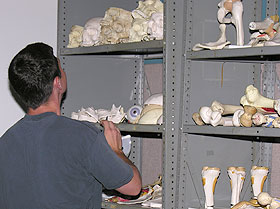  |
| HOME | THIS ISSUE | CALENDAR | GRANTS | BACK ISSUES | < BACK | NEXT > |
First students embark on Doctor of Physical Therapy programby Janice Palmer - September 24, 2007 | ||||
| Anxious students crowd around a necropsy table, shifting from one vantage point to another to get a better look at John Doe. The cadaver is one of four that instructor Bruce Elliott has pulled from the freezer to conduct the clinical portion of the final exam for his Human Anatomy class. This is not medical school, however. This is the Neag School of Education, where the Department of Physical Therapy – part of the Neag School since 2006 – is offering a new advanced degree program. Until now, physical therapy majors earned an integrated bachelor's/master's degree. The last class to graduate with this degree will be in spring 2009. “We’ve moved to the Doctor of Physical Therapy because it’s the direction in which the field is moving,” says Craig Denegar, a newly hired professor who is head of the physical therapy department. Denegar is very familiar with the challenges and benefits of transitioning from a master’s to a doctoral level program. He was a faculty member in physical therapy at Slippery Rock University in Pennsylvania when it became the second program in the country to move to the DPT. That was in 1996. This summer, the American Physical Therapy Association launched a campaign to push the transition to the DPT degree, partly because of rapid advances in health care. Another reason is the issue of direct access. Many states permit direct access, meaning patients can visit a physical therapist without referral from a physician. Federal legislation is currently under consideration that would allow direct access for Medicare patients. When enacted, Denegar predicts, the legislation will further change the landscape of physical therapy practice. The DPT, which requires three years of post-baccalaureate study, “is necessary to keep up with advances in healthcare, with the ultimate goal of providing patients truly quality care,” Denegar says. The DPT is considered the “entry-level” qualification for physical therapists. It is designed for those who’ve earned bachelor’s degrees in any of a number of areas – biology or psychology, for example – and have decided to go into physical therapy.
“We value the experiences non-traditional students can bring to the classroom” says Denegar. The Neag School’s first DPT cohort began this summer, and spent two six-week sessions split between coursework and the cadaver lab. Throughout the first year, their coursework will focus on basic and clinical sciences, as well as health care practices. In the second year, clinical experiences are integrated into the curriculum. During the third year, students will spend 60 percent of their time in supervised clinical practice. By the end, they will have experienced a variety of clinical settings and patient medical needs. Clinical education is at the heart of the DPT program, says Denegar. The Nayden Rehabilitation Clinic, run by the Department of Physical Therapy, serves as a local training site for students while providing care to the University and nearby communities. Students also train at top-notch health care facilities across the country, including Johns Hopkins Hospital, the Mayo Clinic, Brooke Army Hospital, St. Jude Children’s Research Hospital and the Albert Einstein Medical Center. “These centers provide exceptional learning experiences across the breadth of patients cared for by physical therapists,” Denegar says. “We want our students to experience the work being done in centers recognized for excellence. Through those experiences, students integrate and expand the knowledge gained in the classroom.” That facet of the program appealed to Eric Selinsky, a graduate of Campbell University in North Carolina. “I looked at DPT programs at a lot of schools, and selected the UConn program because it was the best option,” he says. “It prepares us to work in a wide variety of settings.” Selinsky is considering a specialization in either in sports medicine or orthopaedics. |
| ADVANCE HOME UCONN HOME |

